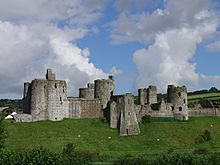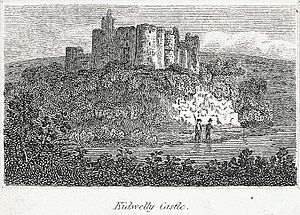Kidwelly Castle facts for kids
Quick facts for kids Kidwelly Castle |
|
|---|---|
| Carmarthenshire, Wales | |

Kidwelly Castle
|
|
| Coordinates | 51°44′22″N 4°18′21″W / 51.7394081°N 4.305735°W |
| Site information | |
| Owner | Cadw |
| Open to the public |
Yes |
| Condition | Ruined |
| Site history | |
| Battles/wars | Revolt of Owain Glyndŵr |
|
Listed Building – Grade I
|
|
Kidwelly Castle (Welsh: Castell Cydweli) is a Norman castle overlooking the River Gwendraeth and the town of Kidwelly, Carmarthenshire, Wales. The origin of this surname traces back to when it was spelled Cygweli which means "swan."
History and description
The present remains of the castle date from the early 12th century. Created as a defence against the Welsh, the castle fell to the Welsh several times in the twelfth century. Later in its history, it was unsuccessfully besieged by forces of Owain Glyndŵr in August 1403 with assistance from soldiers from France and Brittany who captured Kidwelly town. The castle was relieved by a Norman army in September 1403.
The plan of the castle consists of a square inner bailey defended by four round towers, which overlook a semi-circular outer curtain wall on the landward side, with the massive gatehouse next to the river. The river prevents this from being a truly concentric plan, however a jutting tower protects the riverside walls, and the final plan is very strong. The castle is relatively well-preserved, and is managed by Cadw.
The surrounding countryside is reputedly haunted by the headless ghost of Gwenllian ferch Gruffydd, wife of the Welsh prince Gruffydd ap Rhys, who was executed in 1136.
In film
Kidwelly was used as a location for the film Monty Python and the Holy Grail, appearing in the very first scene after the titles.




